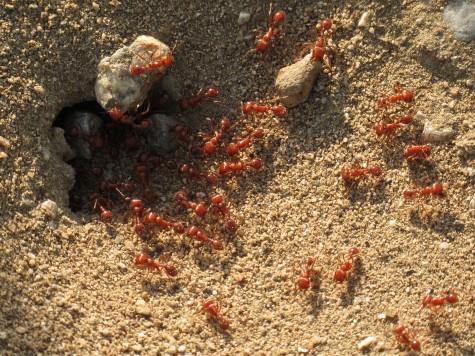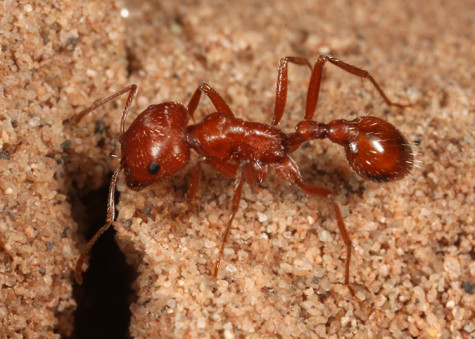It wasn’t just the initial intensity of the pain — a hot, vibrant shard plunging into my metatarsus and radiating up my shinbone — but its duration. From approximately 10 o’clock in the morning, when I stepped barefoot onto a reddish-brown ant in my San Fernando Valley backyard, until well after sunset, the agony defeated Benadryl (oral and topical), ibuprofen, even the one-half of an expired Vicodin I downed with a shot of vodka. Baking soda didn’t draw it out, nor vinegar, nor did calamine lotion calm it down. Ice was my only friend; a series of three Arctic Ice Tundra series packs that I kept in constant rotation from freezer to foot, wrapped in a thin towel and secured with a scarf, numbed the bite. A few seconds without one and I’d curl my toes and twist my face into a muffled scream.
The consensus on my Facebook page, where I’d cast a bid for sympathy, was that I’d been nailed by a red fire ant. A red imported fire ant to be more specific, or RIFA, an invasive destroyer that showed up in California nearly 20 years ago, having traveled up from South America through the southern states in potted plants. RIFAs are bad news; they crowd out native ants, bees and lizards; they kill songbirds, bunnies and toads; they’ve even been known to take down a pig. I would have been entirely justified in my early plan to bomb the colony with vinegar and baking soda once I was mobile again, even if that particular extermination method proved to be less effective than morbidly fun.
By noon, however, I’d begun to have my doubts. Lying in bed with laptop on pillow, I pulled up pictures of RIFA bites: Raised red bumps with blistery pustules. My searing foot, by contrast, had nothing to show for the torture; if you didn’t know better, you’d think I was faking.
There were other differences, too. When I hobbled outside on my ice-pack-platformed foot to take a picture for a biologist friend who said she’d help me identify my attacker, I observed that my ants entered their mound via single large entrance; fire ants, I’d learned in my tormented research, go underground through many diffuse tunnels. My ants were large and uniform; RIFAs are neither.
My ants also appeared spectacularly busy. Despite the raging fury that bloomed in my foot every time I changed ice packs, I crouched outside long enough to see them drag marvels through the dirt: A partially decomposed iridescent scarab beetle, the butt-end of a bee, an inch-long piece of twisted masking tape. The tape ended up over the entrance to their home, and I worried they’d mistakenly trapped themselves. With a gloved hand, I pulled the tape away. A few hours later, they’d pulled it back. It was a triple-digit summer’s day, and I rhapsodized, wholly unscientifically, that they’d drawn a cover over their hole to preserve their subterranean cool. They might have suspected in that moment that their lair was safe from me.
 By the time I emailed the picture, I no longer needed help: I had scoured enough university extension pages to know that I didn’t have fire ants in my backyard. I had harvester ants. A California species, of the genus Pogonomyrmex, so named because they sport little beards that help them gather seeds — pogon means “beard” in Greek. Invasive ants have seriously cut into harvester ant numbers in California, a calamity of great consequence to the horned lizards who relied on them for food. My friend Grace, who grew up blocks from where I live, says that in the 1950s my North Hollywood neighborhood ran lousy with horned lizards; where the fire ants defeated the pogos, the lizards disappeared. And yet here in my bleakly engineered patch of Valley suburbia the harvester ants had come back — invited in, perhaps, by the seedbed I’d unearthed when I tilled up a dead lawn. Even in my woozy, antihistamine-and-ice-dulled fog, I was enraptured.
By the time I emailed the picture, I no longer needed help: I had scoured enough university extension pages to know that I didn’t have fire ants in my backyard. I had harvester ants. A California species, of the genus Pogonomyrmex, so named because they sport little beards that help them gather seeds — pogon means “beard” in Greek. Invasive ants have seriously cut into harvester ant numbers in California, a calamity of great consequence to the horned lizards who relied on them for food. My friend Grace, who grew up blocks from where I live, says that in the 1950s my North Hollywood neighborhood ran lousy with horned lizards; where the fire ants defeated the pogos, the lizards disappeared. And yet here in my bleakly engineered patch of Valley suburbia the harvester ants had come back — invited in, perhaps, by the seedbed I’d unearthed when I tilled up a dead lawn. Even in my woozy, antihistamine-and-ice-dulled fog, I was enraptured.
The revised identification also explained my single, punishing sting: While the California harvester ant’s venom isn’t as toxic as that of her Arizona cousin, which can kill a small mouse in just five bites, all pogo stings are “exceptionally intense and piercing—often maintaining this high level for up to several hours,” reports University of California Los Angeles anthropologist Kevin Groark, who wrote a whole paper about how early Native Americans may have consumed the ants to produce hallucinogenic highs. Arizona entomologist Justin Schmidt’s famous sting-pain index ranks the red harvester ant’s bite as a 3 on a scale of 1 through 4, 4 being the worst.“Bold and unrelenting,” he writes, “like someone is using a power drill to excavate your ingrown toenail.” Or, in my case, boring — no, no, reaming — a hole between your big and little toes. For eight hours.
(The red fire ant, by comparison, can only manage a 1.2 with its sting: “Sharp, sudden and mildly alarming,” says Schmidt.)
The pain subsided late in the evening, almost as quickly as it came, and as completely. By morning it was like nothing had ever happened. By now I’ve passed two biteless weeks in my ragged backyard, resolving to coexist peaceably in the ants’ strange company. My harvester ants bite, yes, but they also viciously defend their colonies from others in their order. E.O. Wilson and Bert Hölldobler, in their book Journey to the Ants, report that California pogos suffer a mortality rate of six percent per hour warring against other kinds of ants. Among those other kinds might be Argentine ants that would parade single-file through the patio door headed for the cat dish, or swarm like fire ants at the slightest disturbance, or invade nasal passages and light fixtures like Rasberry “crazy ants.” Spike my harvester ants, and I could well clear a path for the crazies. So I’m rooting for the pogos. And for me to remember my shoes.
Top photo: California harvester ant, photo courtesy of Navajo Nature; middle photo of harvester ants at work in the Ballona Wetlands of Southern California, via stonebird on Flickr.

My yard recently had an underground nest of yellow jackets establish their nest. $225.00 later I can only wish we could learn how to flavor and eat these invasive species. Invasivors!!!!